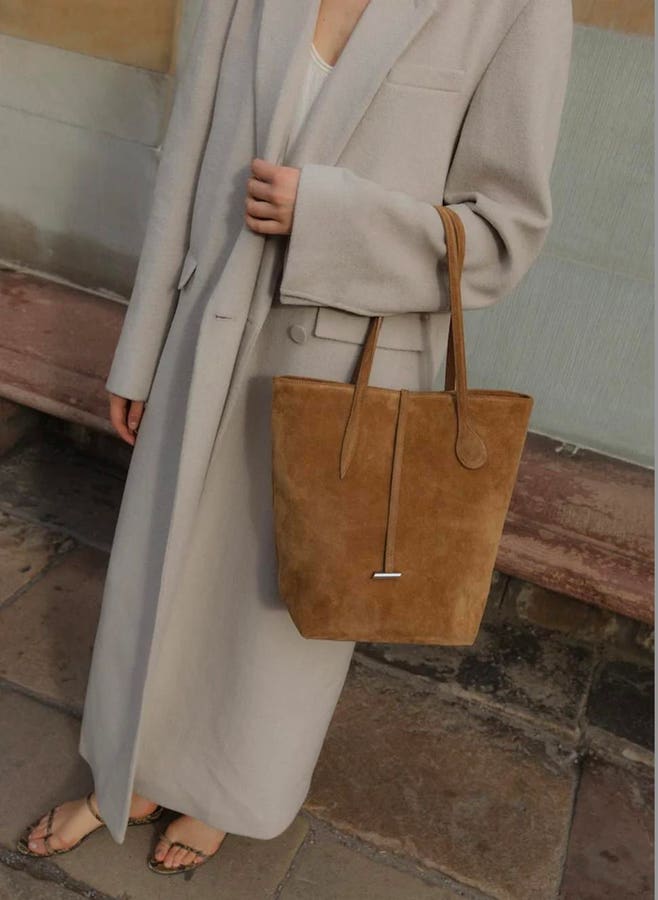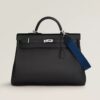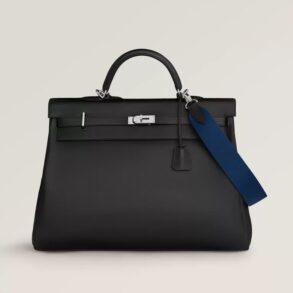
True story: A friend of mine in Los Angeles saw another friend sporting a new suede bag recently on Instagram. The short version is that my friend thinks her other friend makes impeccable fashion choices, but seeing this tote somehow put my L.A. friend over the edge. “How is she always so stylish?” she wanted to know. “Where does she find these insanely beautiful things?” And most importantly: “What the heck is that glorious tote bag she’s carrying?”
Down the rabbit hole she went and up came the answer: the Tall Sprout Tote by Little Liffner: Elegant yet bohemian, chic but offbeat (notice the mismatched strap endings?)—and somehow at a price much closer to affordable than the Birkin and Bottega Veneta bags my friend occasionally covets.
I found all this intriguing (and, okay, amusing) enough to explore further. Apparently my friend (and hers) aren’t the only ones smitten by “LL” bags. Kendall Jenner and Hailey Bieber “can’t get enough” of the totes from the Stockholm-based line. Designed in Sweden and made in Italy, the company plays on modern minimalism with sculptural shapes that have just enough sag and softness to feel like timeless accessories for everyday.
Paulina Liffner von Sydow is the woman behind the bags. A former PR exec in Scandinavia, she switched to handbags in 2012 to extend her sense of creativity and fun and try her hand at a new business. At my friend’s request, I wrote to the Little Liffner founder to ask a few questions:
Paulina Liffner von Sydow is the founder of Little Liffner.
Little Liffner
David Hochman: So much goes into creating an “it” bag. How would you characterize your design philosophy and the uniqueness of what makes your handbags timeless rather than trendy?
Paulina Liffner von Sydow: Growing up Scandinavian meant being immersed in minimal and functional design, so that is my aesthetic default. I want to create bags that are signatures but in a subtle way. I always avoided explicit branding, logos and in your face design details that makes products age with less grace.
David Hochman: What was the breakout moment for you as a designer? The piece or design that made you say, “Oh, this is going to work?”
Paulina Liffner von Sydow: Creating the Tulip Tote and seeing it take off after a few seasons of stubbornly pushing it, was such a moment. A decade in, I still constantly have different types of aha-moments more related to how we position and market the product.
The Soft Tulip Tote that is a perennial best seller for Little Liffner.
Little Liffner
David Hochman: Sustainability is a crucial aspect of your brand, with a preference for natural leathers. What’s the challenge of working with natural leathers and the choice of chrome tanning over vegetable tanning?
Paulina Liffner von Sydow: We work mainly with chrome tanned leathers as they keep their color, structure and look much longer. In the end, if your bag stays beautiful and you can wear and love it for a very long time, that is more sustainable from our perspective tha using a more sustainable leather the quickly deteriorates. All our leathers are sourced from gold and silver LWG certified tanneries.
David Hochman: Your handbags are recognized for their sculptural shapes and pops of color. How do you strike a balance between playful design elements and maintaining a minimalist aesthetic?
Paulina Liffner von Sydow: That is always tricky. I love stripping an idea back to its core and then adding only the essential, to me that’s where the magic happens. I often say that my design philosophy is to explore what it means to be creative within a Scandinavian minimalist framework. Thinking that way helps me stay aesthetically focused.
David Hochman: What’s the future vision for Little Liffner? Knowing that scaling can come with tradeoffs in the fashion industry (as far as quality and demand), how big do you want to grow?
Paulina Liffner von Sydow: Our vision is to be the Scandinavian leather goods brand, so there is plenty of room for growth. We have always grown steadily but slowly. But now I feel like we are finding our stride and we are ready to grow a bit faster. We are currently experiencing high growth in our direct-to-consumer sales as a result of many small strategic decisions in everything from design, assortments, inventory management and marketing panning out which is hugely rewarding to me and my team.
David Hochman: Your brand offers relatively accessible price points compared to many luxury handbag labels. How do you manage to maintain quality and craftsmanship while keeping your products affordable?
Paulina Liffner von Sydow: It helps to be a super lean and highly efficient team and running the business with low overhead costs.
We are a ‘what you see is what you get brand’ and we want to keep on delivering a very premium product at a fairly accessible price point. We certainly want to build a beautiful attractive brand that customers want to buy into, but we don’t want to trick people into paying a super high premium for a brand name and cheaply made product as a lot of luxury brand does. That kind of consumption makes me cringe.
I do believe in the power of fashion as language and how clothes and accessories can make you feel, I want our customers to feel chic, intelligent and fortified in their endeavors.
David Hochman: I read in Vogue that Hailey Bieber and Kendall Jenner have been spotted carrying Little Liffner handbags. What does it mean to you to have such well-known fans of your brand, and how has this impacted your journey?
Paulina Liffner von Sydow: Naturally, it is a great confidence boost as a designer and founder to have people that can chose from anything in the world repeatedly wear your products. And it validates the brand for an aspirational customer.
But at the end of the day it is the smaller, on-brand influencers in our community that we collaborate with daily that drive the most sales for us, and the right kind of sales I think.
David Hochman: Could you share some insights into the creative process behind designing a new handbag collection? Where do you draw inspiration (anything specifically that serves as a muse—like old magazines, a family heirloom, specific music?), and how do you decide on the final designs? When do you know something is finished?
Paulina Liffner von Sydow: I have a big creative reference library that I revisit at the start of each season and my design process involves a lot of trial and error. To find the great simple ideas I first must test and rule out many bad ones.
Merging a commercial and creative perspective is my current focus. For a long time, the brand was driven a lot by my personal taste. I’ve spent my entire career in the fashion industry and my taste is low key but advanced. Now I try to have a wider target audience in mind when I design, and unexpectedly that has led me to easier functional silhouettes that I myself wear more than ever!
To me, something is not finished until it’s perfect, and that will be felt in the gut. The relentless seasonal machine of our industry makes it hard to live after that motto as a designer, but I want to embrace that concept much more going forward.
David Hochman: As founder of Little Liffner, what do you see as the most significant challenges and opportunities in the luxury handbag industry, especially in the context of changing consumer preferences, pricing (they can certainly go to astronomical levels these days) and sustainability concerns
Paulina Liffner von Sydow: When I started out ten years ago the market for independent handbag labels was new territory and in a bit of a frenzy, now it feels like we are going into an extended period of restrain and uncertainty which oddly suits us.
I don’t believe in building a fashion brand overnight, our whole philosophy has always been to never try to get super hot as a brand, because with that comes an inevitable backlash. We want slowly build a genuine following and be a brand that is constantly bubbling under the surface.
Prices in fashion have gone off the charts in recent years, sooner or later it will have to come to an end as people are not making money to the same extent. Our product delivers true value and women wearing our bags recommend them to friends and followers in a very genuine way, which puts us in a good position for healthy growth in the current market.
This interview has been edited and condensed for clarity.
This post was originally published on this site be sure to check out more of their content.







